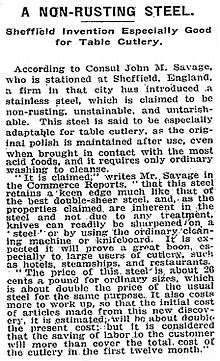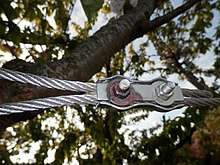Stainless steel
Stainless steel[1][2][3]:276 is a family of iron-based alloys that contain a minimum of approximately 11% chromium,[4]:3[5][6] a composition that prevents the iron from rusting,[7] as well as providing heat-resistant properties.[4]:3[5][8][9][10][11] Different types of stainless steel include the elements carbon (from 0.03% to greater than 1.00%), nitrogen, aluminium, silicon, sulfur, titanium, nickel, copper, selenium, niobium, and molybdenum.[4]:3 Specific types of stainless steel are often designated by a three-digit number, e.g., 304 stainless.
_002.jpg)
| Steels and other iron–carbon alloy phases |
|---|
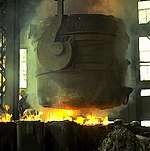 |
| Microstructures |
| Classes |
| Other iron-based materials |
|
Stainless steel's resistance to ferric oxide formation results from the presence of chromium in the alloy, which forms a passive film that protects the underlying material from corrosion attack, and can self-heal in the presence of oxygen.[4]:3 Corrosion resistance can be increased further, by:
- increasing the chromium content to levels above 11%;[5]
- addition of 8% or higher amounts of nickel;[5] and
- addition of molybdenum (which also improves resistance to "pitting corrosion").[5]
The addition of nitrogen also improves resistance to pitting corrosion and increases mechanical strength.[5] Thus, there are numerous grades of stainless steel with varying chromium and molybdenum contents to suit the environment the alloy must endure.[12]
Resistance to corrosion and staining, low maintenance, and familiar luster make stainless steel an ideal material for many applications where both the strength of steel and corrosion resistance are required. Moreover, stainless steel can be rolled into sheets, plates, bars, wire, and tubing. These can be used in cookware, cutlery, surgical instruments, major appliances, construction material in large buildings, industrial equipment (e.g., in paper mills, chemical plants, water treatment), and storage tanks and tankers for chemicals and food products. The material's corrosion resistance, the ease with which it can be steam-cleaned and sterilized, and the absence of the need for surface coatings have prompted the use of stainless steel in kitchens and food processing plants.
History
The invention of stainless steel followed a series of scientific developments, starting in 1798 when chromium was first shown to the French Academy by Louis Vauquelin. In the early 1800s, James Stodart, Michael Faraday, and Robert Mallet observed the resistance of chromium-iron alloys ("chromium steels") to oxidizing agents. Robert Bunsen discovered chromium's resistance to strong acids. The corrosion resistance of iron-chromium alloys may have been first recognized in 1821 by Pierre Berthier, who noted their resistance against attack by some acids and suggested their use in cutlery.[14]
In the 1840s, both Sheffield steelmakers and Krupp were producing chromium steel with the latter employing it for cannons in the 1850s.[15] In 1861, Robert Forester Mushet took out a patent on chromium steel.[16]
These events led to the first production of chromium-containing steel by J. Baur of the Chrome Steel Works of Brooklyn for the construction of bridges. A U.S. Patent for the product was issued in 1869.[1]:2261[17] This was followed with recognition of the corrosion resistance of chromium alloys by Englishmen John T. Woods and John Clark, who noted ranges of chromium from 5–30%, with added tungsten and "medium carbon". They pursued the commercial value of the innovation via a British patent for "Weather-Resistant Alloys".[1]:261,11[18]
In the late 1890s, German chemist Hans Goldschmidt developed an aluminothermic (thermite) process for producing carbon-free chromium. Between 1904 and 1911, several researchers, particularly Leon Guillet of France, prepared alloys that would be considered stainless steel today.[19]
In 1908, Friedrich Krupp Germaniawerft built the 366-ton sailing yacht Germania featuring a chrome-nickel steel hull in Germany. In 1911, Philip Monnartz reported on the relationship between chromium content and corrosion resistance. On 17 October 1912, Krupp engineers Benno Strauss and Eduard Maurer patented austenitic stainless steel as Nirosta.[20][21][22]

Similar developments were taking place in the United States, where Christian Dantsizen and Frederick Becket were industrializing ferritic stainless steel. In 1912, Elwood Haynes applied for a US patent on a martensitic stainless steel alloy, which was not granted until 1919.[23]
While seeking a corrosion-resistant alloy for gun barrels in 1912, Harry Brearley of the Brown-Firth research laboratory in Sheffield, England, discovered and subsequently industrialized a martensitic stainless steel alloy. The discovery was announced two years later in a January 1915 newspaper article in The New York Times.[13]
The metal was later marketed under the "Staybrite" brand by Firth Vickers in England and was used for the new entrance canopy for the Savoy Hotel in London in 1929.[24] Brearley applied for a US patent during 1915 only to find that Haynes had already registered one. Brearley and Haynes pooled their funding and, with a group of investors, formed the American Stainless Steel Corporation, with headquarters in Pittsburgh, Pennsylvania.[1]:360
In the beginning, stainless steel was sold in the US under different brand names like "Allegheny metal" and "Nirosta steel". Even within the metallurgy industry, the name remained unsettled; in 1921, one trade journal called it "unstainable steel".[25] In 1929, before the Great Depression, over 25,000 tons of stainless steel were manufactured and sold in the US annually.[26]
Major technological advances in the 1950s and 1960s allowed the production of large tonnages at an affordable cost:
- AOD Process (argon oxygen decarburization), for the removal of carbon and sulfur
- Continuous casting and hot strip rolling[27]
- The Z-Mill, or Sendzimir cold rolling mill[28][29]
Stainless steel families
There are five main families, which are primarily classified by their crystalline structure: austenitic, ferritic, martensitic, duplex, and precipitation hardening.
Austenitic stainless steel
Austenitic stainless steel[30][31] is the largest family of stainless steels, making up about two-thirds of all stainless steel production (see production figures below).[32] They possess an austenitic microstructure, which is a face-centered cubic crystal structure.[33] This microstructure is achieved by alloying steel with sufficient nickel and/or manganese and nitrogen to maintain an austenitic microstructure at all temperatures, ranging from the cryogenic region to the melting point.[33] Thus, austenitic stainless steels are not hardenable by heat treatment since they possess the same microstructure at all temperatures.[33]
Their yield strength is low (200 to 300 MPa), which limits their use for structural and other load-bearing components. Their elongation is high, which allows for deformation in fabrication processes (such as deep drawing of kitchen sinks). They are weldable by all processes; the most frequently used process is electric arc welding (see welding section below). They are essentially non-magnetic and maintain their ductility at cryogenic temperatures.
Thin sheets and small diameter bars can be strengthened by cold working, with an associated reduction of elongation; however, if they are welded, the welded area will return to the low strength level of the steel before cold working. This limits the use of cold-worked austenitic stainless steels.
Austenitic stainless steels can be further subdivided into two sub-groups, 200 series and 300 series:
- 200 series[34] are chromium-manganese-nickel alloys, which maximize the use of manganese and nitrogen to minimize the use of nickel. Due to their nitrogen addition, they possess approximately 50% higher yield strength than 300 series stainless sheets of steel.
- Type 201 is hardenable through cold working.
- Type 202 is a general-purpose stainless steel. Decreasing nickel content and increasing manganese results in weak corrosion resistance.[35]
- 300 series are chromium-nickel alloys, which achieve their austenitic microstructure almost exclusively by nickel alloying; some very highly-alloyed grades include some nitrogen to reduce nickel requirements. 300 series is the largest group and the most widely used.
- Type 304: The best-known grade is Type 304, also known as 18/8 and 18/10 for its composition of 18% chromium and 8%/10% nickel, respectively.
- Type 316: The second most common austenitic stainless steel is Type 316. The addition of 2% molybdenum provides greater resistance to acids and localized corrosion caused by chloride ions. Low-carbon versions, such as 316L or 304L, have carbon contents below 0.03% and are used to avoid corrosion problems caused by welding[36].
Ferritic stainless steels
Ferritic stainless steels possess a ferrite microstructure like carbon steel, which is a body-centered cubic crystal structure, and contain between 10.5% and 27% chromium with very little or no nickel. This microstructure is present at all temperatures due to the chromium addition, so they are not hardenable by heat treatment. They cannot be strengthened by cold work to the same degree as austenitic stainless steels. They are magnetic.
Additions of niobium (Nb), titanium (Ti), and zirconium (Zr) to Type 430 allow good weldability (see welding section below).
Due to the near-absence of nickel, they are cheaper than austenitic steels and are present in many products, which include:
- Automobile exhaust pipes (Type 409 and 409 Cb are used in North America; stabilized grades Type 439 and 441 are used in Europe)[37]
- Architectural and structural applications (Type 430, which contains 17% Cr)[38]
- Building components, such as slate hooks, roofing, and chimney ducts
- Power plates in solid oxide fuel cells operating at temperatures around 700 °C (1,292 °F) (high-chromium ferritics containing 22% Cr)[39]
Martensitic stainless steels
Martensitic stainless steels offer a wide range of properties and are used as stainless engineering steels, stainless tool steels, and creep-resistant steels. They are magnetic, and not as corrosion-resistant as ferritic and austenitic stainless steels due to their low chromium content. They fall into four categories (with some overlap):[40]
- Fe-Cr-C grades. These were the first grades used and are still widely used in engineering and wear-resistant applications.
- Fe-Cr-Ni-C grades. Some carbon is replaced by nickel. They offer higher toughness and higher corrosion resistance. Grade EN 1.4303 (Casting grade CA6NM) with 13% Cr and 4% Ni is used for most Pelton, Kaplan, and Francis turbines in hydroelectric power plants[41] because it has good casting properties, good weldability and good resistance to cavitation erosion.
- Precipitation hardening grades. Grade EN 1.4542 (also known as 17/4PH), the best-known grade, combines martensitic hardening and precipitation hardening. It achieves high strength and good toughness and is used in aerospace among other applications.
- Creep-resisting grades. Small additions of niobium, vanadium, boron, and cobalt increase the strength and creep resistance up to about 650 °C (1,202 °F).
Heat treatment of martensitic stainless steels
Martensitic stainless steels can be heat treated to provide better mechanical properties.
The heat treatment typically involves three steps:[42]
- Austenitizing, in which the steel is heated to a temperature in the range 980–1,050 °C (1,800–1,920 °F), depending on grade. The resulting austenite has a face-centered cubic crystal structure.
- Quenching. The austenite is transformed into martensite, a hard body-centered tetragonal crystal structure. The quenched martensite is very hard and too brittle for most applications. Some residual austenite may remain.
- Tempering. Martensite is heated to around 500 °C (932 °F), held at temperature, then air-cooled. Higher tempering temperatures decrease yield strength and ultimate tensile strength but increase the elongation and impact resistance.
Nitrogen-alloyed martensitic stainless steels
Replacing some carbon in martensitic stainless steels by nitrogen is a recent development. The limited solubility of nitrogen is increased by the pressure electroslag refining (PESR) process, in which melting is carried out under high nitrogen pressure. Steel containing up to 0.4% nitrogen has been achieved, leading to higher hardness and strength and higher corrosion resistance. As PESR is expensive, lower but significant nitrogen contents have been achieved using the standard argon oxygen decarburization (AOD) process.[43][44][45][46][47]
Duplex stainless steel
Duplex stainless steels have a mixed microstructure of austenite and ferrite, the ideal ratio being a 50:50 mix, though commercial alloys may have ratios of 40:60. They are characterized by higher chromium (19–32%) and molybdenum (up to 5%) and lower nickel contents than austenitic stainless steels. Duplex stainless steels have roughly twice the yield strength of austenitic stainless steel. Their mixed microstructure provides improved resistance to chloride stress corrosion cracking in comparison to austenitic stainless steel Types 304 and 316.
Duplex grades are usually divided into three sub-groups based on their corrosion resistance: lean duplex, standard duplex, and super duplex.
The properties of duplex stainless steels are achieved with an overall lower alloy content than similar-performing super-austenitic grades, making their use cost-effective for many applications. The pulp and paper industry was one of the first to extensively use duplex stainless steel. Today, the oil and gas industry is the largest user and has pushed for more corrosion resistant grades, leading to the development of super duplex and hyper duplex grades. More recently, the less expensive (and slightly less corrosion-resistant) lean duplex has been developed, chiefly for structural applications in building and construction (concrete reinforcing bars, plates for bridges, coastal works) and in the water industry.
Precipitation hardening stainless steels
Precipitation hardening stainless steels have corrosion resistance comparable to austenitic varieties, but can be precipitation hardened to even higher strengths than other martensitic grades. There are three types of precipitation hardening stainless steels:[48]
Solution treatment at about 1,040 °C (1,900 °F)followed by quenching results in a relatively ductile martensitic structure. Subsequent aging treatment at 475 °C (887 °F) precipitates Nb and Cu-rich phases that increase the strength up to above 1000 MPa yield strength. This outstanding strength level is used in high-tech applications such as aerospace (usually after remelting to eliminate non-metallic inclusions, which increases fatigue life). Another major advantage of this steel is that aging, unlike tempering treatments, is carried out at a temperature that can be applied to (nearly) finished parts without distortion and discoloration.
- Semi-austenitic 17-7PH[49] (AISI 631 EN 1.4568) contains about 17% Cr, 7.2% Ni, and 1.2% Al.
Typical heat treatment involves solution treatment and quenching. At this point, the structure remains austenitic. Martensitic transformation is then obtained either by a cryogenic treatment at −75 °C (−103 °F) or by severe cold work (over 70% deformation, usually by cold rolling or wire drawing). Aging at 510 °C (950 °F)—which precipitates the Ni3Al intermetallic phase—is carried out as above on nearly finished parts. Yield stress levels above 1400 MPa are then reached.
- Austenitic A286[50](ASTM 660 EN 1.4980) contains about Cr 15%, Ni 25%, Ti 2.1%, Mo 1.2%, V 1.3%, and B 0.005%.
The structure remains austenitic at all temperatures.
Typical heat treatment involves solution treatment and quenching, followed by aging at 715 °C (1,319 °F). Aging forms Ni3Ti precipitates and increases the yield strength to about 650 MPa at room temperature. Unlike the above grades, the mechanical properties and creep resistance of this steel remain very good at temperatures up to 700 °C (1,292 °F). As a result, A286 is classified as an Fe-based superalloy, used in jet engines, gas turbines, and turbo parts.
Grades
There are over 150 grades of stainless steel, of which 15 are most commonly used. There are several systems for grading stainless and other steels, including US SAE steel grades.
Corrosion resistance
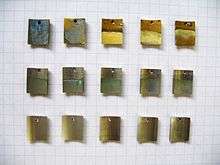
Unlike carbon steel, stainless steels do not suffer uniform corrosion when exposed to wet environments. Unprotected carbon steel rusts readily when exposed to a combination of air and moisture. The resulting iron oxide surface layer is porous and fragile. In addition, as iron oxide occupies a larger volume than the original steel, this layer expands and tends to flake and fall away, exposing the underlying steel to further attack. In comparison, stainless steels contain sufficient chromium to undergo passivation, spontaneously forming a microscopically thin inert surface film of chromium oxide by reaction with the oxygen in the air and even the small amount of dissolved oxygen in the water. This passive film prevents further corrosion by blocking oxygen diffusion to the steel surface and thus prevents corrosion from spreading into the bulk of the metal.[3] This film is self-repairing, even when scratched or temporarily disturbed by an upset condition in the environment that exceeds the inherent corrosion resistance of that grade.[51][52]
The resistance of this film to corrosion depends upon the chemical composition of the stainless steel, chiefly the chromium content. It is customary to distinguish between four forms of corrosion: uniform, localized (pitting), galvanic, and SCC (stress corrosion cracking). Any of these forms of corrosion can occur when the grade of stainless steel is not suited for the working environment.
The designation "CRES" refers to corrosion-resistant steel. Most, but not all, mentions of CRES refer to stainless steel—non-stainless steel materials can also be corrosion-resistant.[53]
Uniform corrosion
Uniform corrosion takes place in very aggressive environments, typically where chemicals are produced or heavily used, such as in the pulp and paper industries. The entire surface of the steel is attacked, and the corrosion is expressed as corrosion rate in mm/year (usually less than 0.1 mm/year is acceptable for such cases). Corrosion tables provide guidelines.[54]
This is typically the case when stainless steels are exposed to acidic or basic solutions. Whether stainless steel corrodes depends on the kind and concentration of acid or base and the solution temperature. Uniform corrosion is typically easy to avoid because of extensive published corrosion data or easily-performed laboratory corrosion testing.
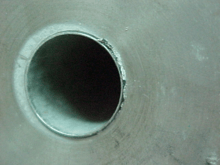
Acids
Acidic solutions can be put into two general categories: reducing acids, such as hydrochloric acid and dilute sulfuric acid, and oxidizing acids, such as nitric acid and concentrated sulfuric acid. Increasing chromium and molybdenum content provides increased resistance to reducing acids while increasing chromium and silicon content provides increased resistance to oxidizing acids.
Sulfuric acid is one of the most-produced industrial chemicals. At room temperature, Type 304 stainless steel is only resistant to 3% acid, while Type 316 is resistant to 3% acid up to 50 °C (122 °F) and 20% acid at room temperature. Thus Type 304 SS is rarely used in contact with sulfuric acid. Type 904L and Alloy 20 are resistant to sulfuric acid at even higher concentrations above room temperature.[55][56] Concentrated sulfuric acid possesses oxidizing characteristics like nitric acid, and thus silicon-bearing stainless steels are also useful.
Hydrochloric acid damages any kind of stainless steel and should be avoided.[4]:118[57]
All types of stainless steel resist attack from phosphoric acid and nitric acid at room temperature. At high concentrations and elevated temperatures, attack will occur, and higher-alloy stainless steels are required.[58][59]
In general, organic acids are less corrosive than mineral acids such as hydrochloric and sulfuric acid. As the molecular weight of organic acids increases, their corrosivity decreases. Formic acid has the lowest molecular weight and is a weak acid. Type 304 can be used with formic acid, though it tends to discolor the solution. Type 316 is commonly used for storing and handling acetic acid, a commercially important organic acid.[60]
Bases
Type 304 and Type 316 stainless steels are unaffected weak bases such as ammonium hydroxide, even in high concentrations and at high temperatures. The same grades exposed to stronger bases such as sodium hydroxide at high concentrations and high temperatures will likely experience some etching and cracking.[61] Increasing chromium and nickel contents provide increased resistance.
Organics
All grades resist damage from aldehydes and amines, though in the latter case Type 316 is preferable to Type 304; cellulose acetate damages Type 304 unless the temperature is kept low. Fats and fatty acids only affect Type 304 at temperatures above 150 °C (302 °F) and Type 316 SS above 260 °C (500 °F), while Type 317 SS is unaffected at all temperatures. Type 316L is required for the processing of urea.[4]
Localized corrosion
Localized corrosion can occur in several ways, e.g. pitting corrosion and crevice corrosion. These localized attacks are most common in the presence of chloride ions. Higher chloride levels require more highly-alloyed stainless steels.
Localized corrosion can be difficult to predict because it is dependent on many factors, including:
- Chloride ion concentration. Even when chloride solution concentration is known, it is still possible for localized corrosion to occur unexpectedly. Chloride ions can become unevenly concentrated in certain areas, such as in crevices (e.g. under gaskets) or on surfaces in vapor spaces due to evaporation and condensation.
- Temperature: increasing temperature increases susceptibility.
- Acidity: increasing acidity increases susceptibility.
- Stagnation: stagnant conditions increase susceptibility.
- Oxidizing species: the presence of oxidizing species, such as ferric and cupric ions, increases susceptibility.
Pitting corrosion resistance
Pitting corrosion is considered the most common form of localized corrosion. The corrosion resistance of stainless steels to pitting corrosion is often expressed by the PREN (pitting resistance equivalent number), obtained through the formula:
- ,
where the terms correspond to the proportion of the contents by mass of chromium, molybdenum, and nitrogen in the steel. For example, if the steel consisted of 15% chromium would be equal to 15.
The higher the PREN, the higher the pitting corrosion resistance. Thus, increasing chromium, molybdenum, and nitrogen contents provide better resistance to pitting corrosion.
Crevice corrosion
Though the PREN of a certain steel may be theoretically sufficient to resist pitting corrosion, crevice corrosion can still occur when poor design has created confined areas (overlapping plates, washer-plate interfaces, etc.) or when deposits form on the material. In these select areas, the PREN may not high enough for the service conditions. Good design and fabrication techniques combined with correct alloy selection can prevent such corrosion.[62]
Stress corrosion cracking
Stress corrosion cracking (SCC) is a sudden cracking and failure of a component without deformation.
It may occur when three conditions are met:
- The part is stressed (by an applied load or by residual stress).
- The environment is aggressive (high chloride level, temperature above 50 °C (122 °F), presence of H2S).
- The stainless steel is not sufficiently SCC-resistant.
The SCC mechanism results from the following sequence of events:
- Pitting occurs.
- Cracks start from a pit initiation site.
- Cracks then propagate through the metal in a transgranular or intergranular mode.
- Failure occurs.
Whereas pitting usually leads to unsightly surfaces and, at worst, to perforation of the stainless sheet, failure by SCC can have severe consequences. It is therefore considered as a special form of corrosion.
As SCC requires several conditions to be met, it can be counteracted with relatively easy measures, including:
- Reducing the stress level (the oil and gas specifications provide requirements for maximal stress level in H2S-containing environments).
- Assessing the aggressiveness of the environment (high chloride content, temperature above 50 °C (122 °F), etc.).
- Selecting the right type of stainless steel: super austenitic such as grade 904L or super-duplex (ferritic stainless steels and duplex stainless steels are very resistant to SCC).
Galvanic corrosion
Galvanic corrosion[63] (also called "dissimilar-metal corrosion") refers to corrosion damage induced when two dissimilar materials are coupled in a corrosive electrolyte. The most common electrolyte is water, ranging from freshwater to seawater. When a galvanic couple forms, one of the metals in the couple becomes the anode and corrodes faster than it would alone, while the other becomes the cathode and corrodes slower than it would alone. Stainless steel, due to having a more positive electrode potential than for example carbon steel and aluminium, becomes the cathode, accelerating the corrosion of the anodic metal. An example is the corrosion of aluminium rivets fastening stainless steel sheets in contact with water.[64]
The relative surface areas of the anode and the cathode are important in determining the rate of corrosion. In the above example, the surface area of the rivets is small compared to that of the stainless steel sheet, resulting in rapid corrosion. [64]However, if stainless steel fasteners are used to assemble aluminium sheets, galvanic corrosion will be much slower because the galvanic current density on the aluminium surface will be an order of magnitude smaller.[64] A frequent mistake is to assemble stainless steel plates with carbon steel fasteners; whereas using stainless steel to fasten carbon-steel plates is usually acceptable, the reverse is not.
Providing electrical insulation between the dissimilar metals, where possible, is effective at preventing this type of corrosion.[64]
High-temperature corrosion (scaling)
At elevated temperatures, all metals react with hot gases. The most common high-temperature gaseous mixture is air, of which oxygen is the most reactive component. To avoid corrosion in air, carbon steel is limited to approximately 480 °C (900 °F). Oxidation resistance in stainless steels increases with additions of chromium, silicon, and aluminium. Small additions of cerium and yttrium increase the adhesion of the oxide layer on the surface.[65]
The addition of chromium remains the most common method to increase high-temperature corrosion resistance in stainless steels; chromium reacts with oxygen to form a chromium oxide scale, which reduces oxygen diffusion into the material. The minimum 10.5% chromium in stainless steels provides resistance to approximately 700 °C (1,300 °F), while 16% chromium provides resistance up to approximately 1,200 °C (2,200 °F). Type 304, the most common grade of stainless steel with 18% chromium, is resistant to approximately 870 °C (1,600 °F). Other gases, such as sulfur dioxide, hydrogen sulfide, carbon monoxide, chlorine, also attack stainless steel. Resistance to other gases is dependent on the type of gas, the temperature, and the alloying content of the stainless steel.[66][67]
With the addition of up to 5% aluminium, ferritic grades Fr-Cr-Al are designed for electrical resistance and oxidation resistance at elevated temperatures. Such alloys include Kanthal, produced in the form of wire or ribbons.[68]
Properties
Physical properties
Properties of a few common grades are listed below.
| Designations | Density (kg/dm3) |
Modulus of elasticity (GPa) |
Mean coefficient of thermal expansion (10−6·K−1) |
Thermal conductivity (W/m·K) |
Specific heat (J/kg·K) |
Electrical resistivity (Ω·mm2/m) | ||
|---|---|---|---|---|---|---|---|---|
| EN [№] | AISI/ASTM | at 20 °C | at 20 °C | 20–200 °C | 20–400 °C | at 20 °C | at 20 °C | at 20 °C |
| Austenitic stainless steels | ||||||||
| 1.4301 | 304 | 7.9 | 200 | 16.5 | 17.5 | 15 | 500 | 0.73 |
| 1.4401 | 316 | 8.0 | 200 | 16.5 | 17.5 | 15 | 500 | 0.75 |
| Duplex stainless steels | ||||||||
| 1.4462 | 2205 | 7.8 | 200 | 13.5 | 14.0 (g) | 15 | 500 | 0.80 |
| 1.4362 | 2304 | 7.8 | 200 | 13.5 | 14.0 (n) | 15 | 500 | 0.80 |
| 1.4501 | 7.8 | 200 | 13.5 | (n.r.) | 15 | 500 | 0.80 | |
| Ferritic stainless steels | ||||||||
| 1.4512 | 409 | 7.7 | 220 | 11.0 | 12.0 | 25 | 460 | 0.60 |
| 1.4016 | 430 | 7.7 | 220 | 10.0 | 10.5 | 25 | 460 | 0.60 |
| Martensitic stainless steels | ||||||||
| 1.4021 | 420 | 7.7 | 215 | 11.0 | 12.0 | 30 | 460 | 0.60 |
| 1.4418 | 7.7 | 200 | 10.8 | 11.6 | 15 | 430 | 0.80 | |
| Precipitation-hardened stainless steels | ||||||||
| 1.4542 | 630 | 7.8 | 200 | 10.8 | 11.6 | 16 | 500 | 0.71 |
Electricity and magnetism
Like steel, stainless steels are relatively poor conductors of electricity, with significantly lower electrical conductivity than copper.
Magnetic properties
Martensitic and ferritic stainless steels are magnetic.
Ferritic steel consists of ferrite crystals, a form of iron with up to 0.025% carbon. Due to its cubic crystalline structure, ferritic steel only absorbs a small amount of carbon, which consists of one iron in each corner and a central iron atom. The central atom is responsible for its magnetic properties.
Grades with low coercitive field Hc have been developed for electrovalves used in household appliances and for injection systems in internal combustion engines. Some applications require non-magnetic materials, such as magnetic resonance imaging.
Annealed austenitic stainless steels are usually non-magnetic, though work hardening can make cold-formed austenitic stainless steels slightly magnetic. Sometimes, if austenitic steel is bent or cut, magnetism occurs along the edge of the stainless steel because the crystal structure rearranges itself.
| EN grade | Magnetic permeability, μ |
|---|---|
| 1.4307 | 1.056 |
| 1.4301 | 1.011 |
| 1.4404 | 1.100 |
| 1.4435 | 1.000 |
Galling
Galling, sometimes called cold welding, is a form of severe adhesive wear, which can occur when two metal surfaces are in relative motion to each other and under heavy pressure. Austenitic stainless steel fasteners are particularly susceptible to thread galling, though other alloys that self-generate a protective oxide surface film, such as aluminium and titanium, are also susceptible. Under high contact-force sliding, this oxide can be deformed, broken, and removed from parts of the component, exposing the bare reactive metal. When the two surfaces are of the same material, these exposed surfaces can easily fuse. Separation of the two surfaces can result in surface tearing and even complete seizure of metal components or fasteners.[70][71]
Galling can be mitigated by the use of dissimilar materials (bronze against stainless steel) or using different stainless steels (martensitic against austenitic). Additionally, threaded joints may be lubricated to provide a film between the two parts and prevent galling. Nitronic 60, made by selective alloying with manganese, silicon, and nitrogen, has demonstrated a reduced tendency to gall.[71]
Standard finishes
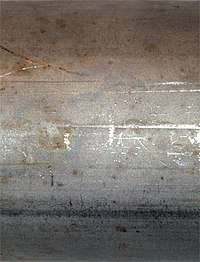
Standard mill finishes can be applied to flat rolled stainless steel directly by the rollers and by mechanical abrasives. Steel is first rolled to size and thickness and then annealed to change the properties of the final material. Any oxidation that forms on the surface (mill scale) is removed by pickling, and a passivation layer is created on the surface. A final finish can then be applied to achieve the desired aesthetic appearance.
The following designations are used to describe stainless steel finishes:
- No. 0: Hot-rolled, annealed, thicker plates
- No. 1: Hot-rolled, annealed and passivated
- No. 2D: Cold rolled, annealed, pickled and passivated
- No. 2B: Same as above with additional pass through highly polished rollers
- No. 2BA: Bright annealed (BA or 2R) same as above then bright annealed under oxygen-free atmospheric condition
- No. 3: Coarse abrasive finish applied mechanically
- No. 4: Brushed finish
- No. 5: Satin finish
- No. 6: Matte finish (brushed but smoother than #4)
- No. 7: Reflective finish
- No. 8: Mirror finish
- No. 9: Bead blast finish
- No. 10: Heat colored finish – offering a wide range of electropolished and heat colored surfaces
Joining stainless steels
A wide range of joining processes are available for stainless steels, though welding is by far the most common.[72][36]
Welding stainless steels
The ease of welding largely depends on the type of stainless steel used. Austenitic stainless steels are the easiest to weld by electric arc, with weld properties similar to those of the base metal (not cold-worked). Martensitic stainless steels can also be welded by electric-arc but, as the heat-affected zone (HAZ) and the fusion zone (FZ) form martensite upon cooling, precautions must be taken to avoid cracking of the weld. Post-weld heat treatment is almost always required while preheating before welding is also necessary in some cases.[36]
Electric arc welding of Type 430 ferritic stainless steel results in grain growth in the heat-affected zone (HAZ), which leads to brittleness. This has largely been overcome with stabilized ferritic grades, where niobium, titanium, and zirconium form precipitates that prevent grain growth.[73][74] Duplex stainless steel welding by electric arc is a common practice but requires careful control of the process parameters. Otherwise, the precipitation of unwanted intermetallic phases occurs, which reduces the toughness of the welds.[75]
Electric arc welding processes [72]
- Gas metal arc welding, also known as metal inert gas (MIG) welding
- Gas tungsten arc welding, also known as tungsten inert gas (TIG) welding
- Plasma arc welding
- Flux-cored arc welding
- Shielded metal arc welding (covered electrode)
- Submerged arc welding
MIG and TIG welding are the most common methods used.
Other welding processes
- Stud welding
- Resistance spot welding
- Resistance seam welding
- Flash welding
- Laser beam welding
Adhesive bonding
Stainless steel may be bonded with adhesives such as silicone, silyl modified polymers, and epoxies. Acrylic and polyurethane adhesives are also used in some situations.[76]
Production process and figures
Production process
Most of the world's stainless steel production is produced by the following processes:
- Electric arc furnace (EAF): stainless steel scrap, other ferrous scrap, and ferrous alloys (Fe Cr, Fe Ni, Fe Mo, Fe Si) are melted together. The molten metal is then poured into a ladle and transferred into the AOD process (see below).
- Argon oxygen decarburization (AOD): carbon in the molten steel is removed (by turning it into carbon monoxide gas) and other compositional adjustments are made to achieve the desired chemical composition.
- Continuous casting (CC): the molten metal is solidified into slabs for flat products (a typical section is 20 centimetres (8 in) thick and 2 metres (6.6 ft) wide) or blooms (sections vary widely but 25 by 25 centimetres (9.8 in × 9.8 in) is the average size).
- Hot rolling (HR): slabs and blooms are reheated in a furnace and hot-rolled. Hot rolling reduces the thickness of the slabs to produce about 3 mm (0.12 in)-thick coils. Blooms, on the other hand, are hot-rolled into bars, which are cut into lengths at the exit of the rolling mill, or wire rod, which is coiled.
- Cold finishing (CF) depends on the type of product being finished:
- Hot-rolled coils are pickled in acid solutions to remove the oxide scale on the surface, then subsequently cold rolled in Sendzimir rolling mills and annealed in a protective atmosphere until the desired thickness and surface finish is obtained. Further operations such as slitting and tube forming can be performed in downstream facilities.
- Hot-rolled bars are straightened, then machined to the required tolerance and finish.
- Wire rod coils are subsequently processed to produce cold-finished bars on drawing benches, fasteners on boltmaking machines, and wire on single or multipass drawing machines.
Production figures
World stainless steel production figures are published yearly by the International Stainless Steel Forum.[32]
| Year | World | |||||
|---|---|---|---|---|---|---|
| 2019 | 6805 | 2593 | 29400 | 7894 | 5525 | 52218 |
| 2018 | 7386 | 2808 | 26706 | 8195 | 5635 | 50729 |
| 2017 | 7377 | 2754 | 25774 | 8030 | 4146 | 48081 |
| 2016 | 7280 | 2931 | 24938 | 9956 | 672 | 45778 |
| 2015 | 7169 | 2747 | 21562 | 9462 | 609 | 41548 |
| 2014 | 7252 | 2813 | 21692 | 9333 | 595 | 41686 |
| 2013 | 7147 | 2454 | 18984 | 9276 | 644 | 38506 |
Breakdown of production by stainless steels families in 2017:
- Austenitic stainless steels Cr-Ni (also called 300-series, see "Grades" section above): 54%
- Austenitic stainless steels Cr-Mn (also called 200-series): 21%
- Ferritic and martensitic stainless steels (also called 400-series): 23%
Applications
Architecture
The use of stainless steel in buildings can be both practical and aesthetic. In vogue during the Art Deco period, the most famous use of stainless steel can be seen in the upper portion of the Chrysler Building. Thanks to its durability, many of these buildings have retained their original appearance.
Stainless steel is used in the construction of modern buildings, such as the exterior of the Petronas Twin Towers and the Jin Mao Building.[77] The Parliament House of Australia in Canberra has a stainless steel flagpole weighing over 220 metric tons (240 short tons).[78] The largest stainless steel building in North America is the aeration building in the Edmonton Composting Facility.[79] La Geode in Paris has a dome composed of 6433 polished stainless steel equilateral triangles that form the sphere that reflects the sky.[80] The development of high-strength stainless steel grades, such as "lean duplex" grades, has led to increasing use in structural applications.[81][82]
Thanks to its low reflectivity, stainless steel is used as a roofing material for airports, which prevents pilots from being dazzled. It is also used for its ability to keep the surface of the roof close to ambient temperature. Examples of such airports include the Sacramento International Airport in California and the Hamad International Airport in Qatar.
Stainless steel is used for pedestrian and road bridges in the form of tubes, plates, or reinforcing bars.[83] Examples include: the Cala Galdana Bridge in Menorca, the first stainless steel road bridge to be built; the Champlain Bridge in Montreal;[83] the Oudesluijs bridge in Amsterdam, a bridge made using Construction 3D printing;[84] the Padre Arrupe Bridge in Bilbao, which links the Guggenheim Museum Bilbao to the University of Deusto.[85] the Sant Fruitos Pedestrian Bridge in Spain; Stonecutter's Bridge, Hong Kong;[83] and The Helix Bridge, a pedestrian bridge in Singapore.
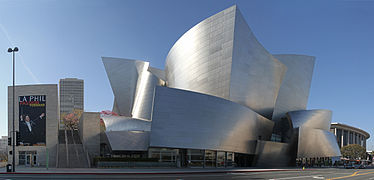 Stainless steel cladding is used on the Walt Disney Concert Hall
Stainless steel cladding is used on the Walt Disney Concert Hall
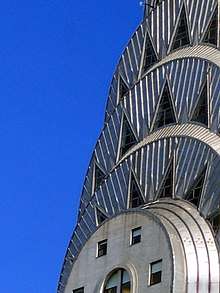 The pinnacle of New York's Chrysler Building is clad with Nirosta stainless steel, a form of Type 302[86][77]
The pinnacle of New York's Chrysler Building is clad with Nirosta stainless steel, a form of Type 302[86][77]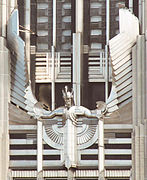 An Art Deco sculpture on the Niagara-Mohawk Power building in Syracuse, New York
An Art Deco sculpture on the Niagara-Mohawk Power building in Syracuse, New York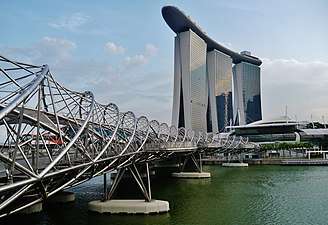
Use in art and monuments
Americas
- Cloud Gate, a sculpture by Anish Kapoor. (Chicago, United States)
- Gateway Arch (pictured) is clad entirely in stainless steel: 886 tons (804 metric tons) of 0.25 in (6.4 mm) plate, #3 finish, type 304 stainless steel.[87] (St. Louis, United States)
- Jaime Latapí López's Cristo de Chiapas. Created in 2007. (Tuxla Guttierez, Mexico)
- Metamorphosis by David Černỳ. Created in 2011 (Charlotte, United States)[88]
- Unisphere, constructed as the theme symbol of the 1964 New York World's Fair, is constructed of Type 304L stainless steel as a spherical framework with a diameter of 120 feet (37 m). (New York City, United States)
- United States Air Force Memorial has an austenitic stainless steel structural skin. (Arlington, United States)
Asia
- The Blossom pavilion by Zhan Wang. Created in 2015. (Shanghai, China)
Europe
- The aluminium cladding of the spheres and tubes of the Atomium was renovated with stainless-steel cladding in 2006. (Brussels, Belgium)
- Juraj Jánošík monument (Terchova, Slovakia)
- La danse de la fontaine émergente by Chen Zhen. Created in 2008. (Paris, France)
- Man of Steel (sculpture), currently under construction. (Rotherham, England)
- The Sibelius Monument is made entirely of stainless steel tubes (Helsinki, Finland)
- Sun Voyager by Jon Gunnar Arnason 9 m × 18 m × 7 m. Created in 1990. (Reykjavik, Iceland)
- The Big Elk by Linda Bakke. Created in 2015. (Stor-Eldval, Norway)
- The Kelpies (Falkirk, Scotland)
Water
Stainless steels have a long history of application in contact with water[89] due to their excellent corrosion resistance. Applications include a range of conditions including plumbing,[90] potable water[91] and wastewater treatment,[92] desalination, and brine treatment.[93][94] Types 304 and 316 stainless steels are standard materials of construction in contact with water. However, with increasing chloride contents, higher alloyed stainless steels such as Type 2205 and super austenitic and super duplex stainless steels are used.[95]
Important considerations to achieve optimum corrosion performance are:[96]
- the correct grade choice for the chloride content of the water;
- avoidance of crevices when possible by good design;
- adherence to good fabrication practices, particularly removing weld heat tint;
- prompt drainage after hydrotesting.
The use of stainless steel piping has helped to reduce the losses of drinking water in Tokyo, Seoul, and Taipei.[97]
Pulp, paper, and biomass conversion
Stainless steels are used extensively in the pulp and paper industry to avoid iron contamination of the product and because of their corrosion resistance to the various chemicals used in the papermaking process.[98][99] For example, duplex stainless steels are used in digesters to convert wood chips into wood pulp. 6% Mo superaustenitics are used in the bleach plant and Type 316 is used extensively in the paper machine.
Chemical and petrochemical processing
Stainless steels are used extensively in the chemical and petrochemical industries for their corrosion resistance to aqueous, gaseous, and high-temperature environments, their mechanical properties at all temperatures, and occasionally for other special physical properties.[100][101][102][103]
Food and beverage
Austenitic (300 series) stainless steel, particularly Types 304 and 316, is the material of choice for the food and beverage industry, though martensitic and ferritic (400 series) steels are also used. Stainless steels are advantageous because they do not affect the taste of the product, are easily cleaned and sterilized to prevent bacterial contamination of the food, and are durable. Within the food and beverage industry, stainless steel is extensively used in cookware, commercial food processing, commercial kitchens, brewing beer, winemaking, and meat processing.[104]
Acidic foods with high salt additions, such as tomato sauce, and highly salted condiments, such as soy sauce, may require higher-alloyed stainless steels such as 6% Mo superaustenitics to prevent pitting corrosion by chloride.
Vehicles
- Automobiles
The Allegheny Ludlum Corporation worked with Ford on various concept cars with stainless steel bodies from the 1930s through the 1970s to demonstrate the material's potential. The 1957 and 1958 Cadillac Eldorado Brougham had a stainless steel roof. In 1981 and 1982, the DMC DeLorean production automobile used Type 304 stainless steel body panels over a glass-reinforced plastic monocoque. Intercity buses made by Motor Coach Industries are partially made of stainless steel. The aft body panel of the Porsche Cayman model (2-door coupe hatchback) is made of stainless steel. Due to the Cayman's many curves and angles, it was discovered during early body prototyping that conventional steel could not be formed without cracking. Thus, Porsche was forced to use stainless steel.
The largest use of stainless steel in cars is the exhaust line. Environment protection requirements aimed at reducing pollution and noise for the entirety of a car's lifespan led to the use of ferritic stainless steels (typically AISI409/409Cb in North America, EN1.4511 and 1.4512 in Europe). They are used for collector, tubing, muffler, catalytic converter, tailpipe. Heat-resisting grades EN1.4913 or 1.4923 are used in parts of turbochargers, while other heat-resisting grades are used for exhaust gas recirculation and for inlet and exhaust valves. In addition, common rail injection systems and their injectors rely on stainless steels.
Stainless steel has proved to be the best choice for miscellaneous applications, such as stiffeners for windshield wiper blades, balls for seat belt operation device in case of accident, springs, fasteners, etc.
Some automotive manufacturers use stainless steel as decorative highlights in their vehicles.
Light commuter trains (Tram links)
Stainless steel is now used as one of the materials for tramlinks, together with aluminium alloys and carbon steel. Duplex grades tend to be preferred thanks to their corrosion resistance and higher strength, allowing a reduction of weight and a long life in maritime environments.[105]
- Passenger rail cars
Rail cars have commonly been manufactured using corrugated stainless steel panels for additional structural strength. This was particularly popular during the 1960s and 1970s but has since declined. One notable example was the early Pioneer Zephyr. Notable former manufacturers of stainless steel rolling stock included the Budd Company (USA), which has been licensed to Japan's Tokyu Car Corporation, and the Portuguese company Sorefame. Many railcars in the United States are still manufactured with stainless steel. In India, where rail infrastructure is developing, new stainless steel coaches in being put into service.[106] South Africa is also commissioning stainless steel coaches.[107]
- Aircraft
Budd also built two airplanes, the Budd BB-1 Pioneer and the Budd RB-1 Conestoga, out of stainless steel tube and sheet. The first, which had fabric wing coverings, is on display at the Franklin Institute, being the longest continuous display of an aircraft ever, since 1934. The RB-2 was almost all stainless steel, save for the control surfaces. One survives at the Pima Air & Space Museum, adjacent to Davis–Monthan Air Force Base.
The American Fleetwings Sea Bird amphibious aircraft of 1936 was also built using a spot-welded stainless steel hull.
Due to its thermal stability, the Bristol Aeroplane Company built the all-stainless steel Bristol 188 high-speed research aircraft, which first flew in 1963. However, the practical problems encountered meant that later high-speed aircraft, such as the Concorde, employed aluminium alloys. Similarly, the experimental Mach 3 American bomber, the XB70 Valkyrie, made extensive use of stainless steel in its external structure due to the extreme heat encountered at those high speeds.
The use of stainless steel in mainstream aircraft is hindered by its excessive weight compared to other materials, such as aluminium.
- Spacecraft
Stainless steel also has an application in spaceflight. The early Atlas rockets used stainless steel in their fuel tanks. The outer cladding of the modules and the Integrated Truss Structure of the International Space Station use stainless steel alloys.[108] Components of the future Space Launch System and the structural shell of the SpaceX Starship will be the second and third rockets respectively to use stainless steel.
Medicine
Surgical tools and medical equipment are usually made of stainless steel, because of its durability and ability to be sterilized in an autoclave. In addition, surgical implants such as bone reinforcements and replacements (e.g. hip sockets and cranial plates) are made with special alloys formulated to resist corrosion, mechanical wear,[109] and biological reactions in vivo.
Stainless steel is used in a variety of applications in dentistry. It is common to use stainless steel in many instruments that need to be sterilized, such as needles,[110] endodontic files in root canal therapy, metal posts in root canal-treated teeth, temporary crowns and crowns for deciduous teeth, and arch wires and brackets in orthodontics.[111] Surgical stainless steel alloys (e.g., 316 low-carbon steel) have also been used in some early dental implants.[112]
Energy
Stainless steels are extensively used in all types of power stations, from nuclear[113] to solar.[114] Stainless steels are ideally suited as mechanical supports for power generation units when the permeation of gases or liquids are required, such as filters in cooling water or hot gas clean up[115] or as structural supports in electrolytic power generation.[116]
Stainless steel is used in electrolysers (proton exchange membranes and solid oxide electrolysers being the most common) that convert electrical energy into hydrogen gas by water electrolysis. Conversely, stainless steel is used in fuel cells which perform the opposite reaction, combining hydrogen and oxygen to produce water and electrical energy.
Culinary
Stainless steel is often preferred for kitchen sinks because of its ruggedness, durability, heat resistance, and ease of cleaning. In better models, acoustic noise is controlled by applying resilient undercoating to dampen vibrations. The material is also used for cladding of surfaces such as appliances and backsplashes.
Cookware and bakeware may be clad in stainless steels to enhance their cleanability and durability and to permit their use in induction cooking (this requires a magnetic grade of stainless steel, such as 432). Because stainless steel is a poor conductor of heat, it is often used as a thin surface cladding over a core of copper or aluminium, which conducts heat more readily.
Cutlery is often made of stainless steel,[117] for low corrosion, ease of cleaning, negligible toxicity, and ability to avoid flavoring the food by[118] electrolytic activity.
Jewelry
Stainless steel is used for jewelry and watches, with 316L being the type commonly used. Oxidizing stainless steel briefly gives it radiant colors that can also be used for coloration effects.[119] Valadium, stainless steel, and 12% nickel alloy is used to make class and military rings. Valadium is usually silver-toned but can be electro-plated to give it a gold-tone. The gold tone variety is known as Sun-lite Valadium.[120] Other Valadium types of alloy are trade-named differently, with such names as "Siladium" and "White Lazon."
Firearms
Some firearms incorporate stainless steel components as an alternative to blued or parkerized steel. Some handgun models, such as the Smith & Wesson Model 60 and the Colt M1911 pistol, can be made entirely from stainless steel. This gives a high-luster finish similar in appearance to nickel plating. Unlike plating, the finish is not subject to flaking, peeling, wear-off from rubbing (as when repeatedly removed from a holster), or rust when scratched.
3D printing
Some 3D printing providers have developed proprietary stainless steel sintering blends for use in rapid prototyping. One popular stainless steel grade used in 3D printing is 316L stainless steel. Due to the high temperature gradient and fast rate of solidification, stainless steel products manufactured via 3D printing tend to have a more refined microstructure; this, in turn, results in better mechanical properties. However, stainless steel is not as commonly used as materials like Ti6Al4V, due to the availability of more cost-effective traditional manufacturing methods for stainless steel.
Life cycle cost
Life cycle cost (LCC) calculations are used to select the design and the materials that will lead to the lowest cost over the whole life of a project, such as a building or a bridge.[121][122]
The formula, in a simple form, is the following:[123][124]
where LCC is the overall life cycle cost, AC is the acquisition cost, IC the installation cost, OC the operating and maintenance costs, LP the cost of lost production due to downtime, and RC the replacement materials cost.
In addition, N is the planned life of the project, i the interest rate, and n the year in which a particular OC or LP or RC is taking place. The interest rate (i) is used to convert expenses from different years to their present value (a method widely used by banks and insurance companies) so they can be added and compared fairly. The usage of the sum formula () captures the fact that expenses over the lifetime of a project must be cumulated after they are corrected for interest rate.
Application of LCC in materials selection
Stainless steel used in projects often results in lower LCC values compared to other materials. The higher acquisition cost (AC) of stainless steel components are often offset by improvements in operating and maintenance costs, reduced loss of production (LP) costs, and the higher resale value of stainless steel components.
LCC calculations are usually limited to the project itself. However, there may be other costs that a project stakeholder may wish to consider:
- Utilities, such as power plants, water supply & wastewater treatment, and hospitals, cannot be shut down. Any maintenance will require extra costs associated with continuing service.
- Indirect societal costs (with possible political fallout) may be incurred in some situations such as closing or reducing traffic on bridges, creating queues, delays, loss of working hours to the people, and increased pollution by idling vehicles.
Sustainability–recycling and reuse
The average carbon footprint of stainless steel (all grades, all countries) is estimated to be 2.90 kg of CO2 per kg of stainless steel produced,[125] of which 1.92 kg are emissions from raw materials (Cr, Ni, Mo); 0.54 kg from electricity and steam, and 0.44 kg are direct emissions (i.e., by the stainless steel plant). Note that stainless steel produced in countries that use cleaner sources of electricity (such as France, which uses nuclear energy) will have a lower carbon footprint. Ferritics without Ni will have a lower CO2 footprint than austenitics with 8% Ni or more.
Carbon footprint must not be the only sustainability-related factor for deciding the choice of materials:
- over any product life, maintenance, repairs or early end of life (planned obsolescence) can increase its overall footprint far beyond initial material differences. In addition, loss of service (typically for bridges) may induce large hidden costs, such as queues, wasted fuel, and loss of man-hours.
- how much material is used to provide a given service varies with the performance, particularly the strength level, which allows lighter structures and components.
Stainless steel is 100% recyclable.[126][127][128] An average stainless steel object is composed of about 60% recycled material of which approximately 40% originates from end-of-life products, while the remaining 60% comes from manufacturing processes.[129] What prevents a higher recycling content is the availability of stainless steel scrap, in spite of a very high recycling rate. According to the International Resource Panel's Metal Stocks in Society report, the per capita stock of stainless steel in use in society is 80–180 kg in more developed countries and 15 kg in less-developed countries. There is a secondary market that recycles usable scrap for many stainless steel markets. The product is mostly coil, sheet, and blanks. This material is purchased at a less-than-prime price and sold to commercial quality stampers and sheet metal houses. The material may have scratches, pits, and dents but is made to the current specifications.
Stainless steel cycle
The stainless steel cycle starts with carbon steel scrap, primary metals, and slag.
The next step is the production of hot-rolled and cold-finished steel products in steel mills. Some scrap is produced, which is directly reused in the melting shop.
The manufacturing of components is the third step. Some scrap is produced and enters the recycling loop. Assembly of final goods and their use does not generate any material loss.
The fourth step is the collection of stainless steel for recycling at the end of life of the goods (such as kitchenware, pulp and paper plants, or automotive parts). This is where it is most difficult to get stainless steel to enter the recycling loop, as shown in the table below:
| End-use sector | Results | Use, global average | Estimates | |||||
|---|---|---|---|---|---|---|---|---|
| 2000 | 2005 | Average lifetime (years) |
Coefficient of variation |
To landfill | Collected for recycling | |||
| Total | Of which as stainless steel | Of which as carbon steel | ||||||
| Building and infrastructure | 17% | 18% | 50 | 30% | 8% | 92% | 95% | 5% |
| Transportation (total) | 21% | 18% | 13% | 87% | 85% | 15% | ||
| Of which passenger cars | 17% | 14% | 14 | 15% | ||||
| Of which others | 4% | 4% | 30 | 20% | ||||
| Industrial Machinery | 29% | 26% | 25 | 20% | 8% | 92% | 95% | 5% |
| Household appliances & electronics | 10% | 10% | 15 | 20% | 30% | 70% | 95% | 5% |
| Metal Goods | 23% | 27% | 15 | 25% | 40% | 60% | 80% | 20% |
Nanoscale stainless steel
Stainless steel nanoparticles have been produced in the laboratory.[131][132] These may have applications as additives for high-performance applications. For example, sulfurization, phosphorization, and nitridation treatments to produce nanoscale stainless steel based catalysts could enhance the electrocatalytic performance of stainless steel for water splitting.[133]
Health effects
Welding
There is extensive research indicating some probable increased risk of cancer (particularly lung cancer) from inhaling welding fumes while welding stainless steel.[134][135][136][137][138][139] Stainless steel welding is suspected of producing carcinogenic fumes from cadmium oxides, nickel, and chromium.[140] According to Cancer Council Australia, "In 2017, all types of welding fumes were classified as a Group 1 carcinogen."[140]
Cooking
Stainless steel is generally considered to be biologically inert. However, during cooking, small amounts of nickel and chromium leach out of new stainless steel cookware into highly acidic food[141]. Nickel can contribute to cancer risks—particularly lung cancer and nasal cancer.[142][143] However, no connection between stainless steel cookware and cancer has been established.[144]
See also
- AL-6XN weldable stainless steel
- Argon oxygen decarburization
- Chrome-cobalt alloys
- Corrugated stainless steel tubing
- Crucible Industries
- List of blade materials
- List of steel producers
- Marine grade stainless
- Pilling–Bedworth ratio
- Pitting resistance equivalent number
- Rouging
- Stainless steel fiber
- Stainless steel soap
References
- Cobb, Harold M. (2010). The History of Stainless Steel. Materials Park, OH: ASM International. ISBN 9781615030118. Retrieved 8 March 2020.CS1 maint: uses authors parameter (link)
- Peckner, Donald; Bernstein, I.M. (1977). Handbook of Stainless Steels. McGraw Hill. ISBN 9780070491472.
- Lacombe, P.; Baroux, B.; Beranger, G. (1990). Les Aciers Inoxydables. Les Editions de Physique. ISBN 2-86883-142-7.
- Davis, Joseph R. (ed.) (1994). Stainless Steels. ASM Specialty Handbook. Materials Park, OH: ASM International. ISBN 9780871705037. Retrieved 8 March 2020.CS1 maint: uses authors parameter (link)
- ISSF Staff (8 March 2020). "The Stainless Steel Family" (PDF). Brussels, Belgium: International Stainless Steel Forum. p. 1, of 5. Retrieved 8 March 2020.
- The ISSF whitepaper cited immediately preceding this note states "a minimum of 10.5% chromium", which is more specific than but consistent with Davis, op. cit.
- Rust refers hydrated forms of ferric oxide, that is, to the "reddish brittle coating formed on iron especially when chemically attacked by moist air", see Merriam-Webster.com, op. cit.
- “Rust” and "Ferric oxide". Merriam-Webster.com Dictionary, Springfield, MA: Merriam-Webster, Accessed 8 March 2020.
- "Definition of RUST". www.merriam-webster.com.
- “Corrosion" Chemical process". Encyclopædia Britannica, Chicago, IL: Encyclopædia Britannica, Accessed 8 March 2020.
- "Corrosion | chemical process". Encyclopedia Britannica.
- Chapter 05: Corrosion Resistance of Stainless Steels https://www.imoa.info/download_files/stainless-steel/issf/educational/Module_05_Corrosion_Resistance_of_Stainless_Steels_en.pdf
- "A non-rusting steel". New York Times. 31 January 1915.
- Cobb, Harold M. (2010). The History of Stainless Steel. ISBN 9781615030118.
- Quentin r. Skrabec, Jr (24 January 2015). The Metallurgic Age: The Victorian Flowering of Invention and Industrial Science. ISBN 9781476611136.
- https://babel.hathitrust.org/cgi/pt?id=mdp.39015014665320&view=1up&seq=902
- Despite the evidence of the use of Baur's "chrome steel" in bridgeworks, others have argued that metallurgists of the 19th century were unable to produce anything but high-chromium alloys that were "too brittle to be practical".
- "It's Complicated: The Discovery of Stainless Steel". Airedale Springs. September 2015.
- "The Discovery of Stainless Steel".
- "ThyssenKrupp Nirosta: History". Archived from the original on 2 September 2007. Retrieved 13 August 2007.
- "DEPATISnet-Dokument DE000000304126A".
- "DEPATISnet-Dokument DE000000304159A".
- Carlisle, Rodney P. (2004) Scientific American Inventions and Discoveries, p. 380, John Wiley and Sons, ISBN 0-471-24410-4.
- Howse, Geoffrey (2011) A Photographic History of Sheffield Steel, History Press, ISBN 0752459856.
- Moneypenny, J. H. G. (1921). "Unstainable Steel". Mining and Scientific Press. Retrieved 17 February 2013.
- "New Steel Alloy is Rustproof". Popular Science. Bonnier Corporation. December 1930. pp. 31–. ISSN 0161-7370.
- Lenard, John G. (2014). Primer on flat rolling. Science Direct. ISBN 978-0-08-099418-5.
- "Sendzimir | Company Info | Company History".
- Ikeda, Satoshi (2010). "Technical Progress of Stainless Steel and its future trend" (PDF). Nippon Steel. Nippon Steel.
- Stainless steels for design engineers (#05231G). https://www.asminternational.org/search/-/journal_content/56/10192/05231G/PUBLICATION: ASM International. 2008. pp. 69–78 (Chapter 6). ISBN 978-0-87170-717-8.CS1 maint: location (link)
- McGuire, Michael F. (2008). Practical Guidelines for the Fabrication of High Performance Austenitic Stainless Steels. ISBN 978-0-87170-717-8.
- "INTERNATIONL STAINLESS STEEL FORUM".
- "Microstructures in Austenitic Stainless Steels :: Total Materia Article". www.totalmateria.com. Retrieved 23 June 2020.
- Bristish Stainless Steel Association (August 2006). "200 Series Stainless Steels. An overview". Stainless Steel Industry.
- Habara, Yasuhiro. Stainless Steel 200 Series: An Opportunity for Mn Archived 8 March 2014 at the Wayback Machine. Technical Development Dept., Nippon Metal Industry, Co., Ltd.
- "Welding of stainless steels and other joining methods" (PDF). Nickel Institute.
- Santacreu, P-O; Faivre, L.; Acher, A.; Leseux, J. (2011). K4X: A new ferritic stainless steel grade with improved durability for high temperature exhaust manifolds. Proceedings of 7th European Stainless Steel Science & Market (Como, Italy) Paper 25.
- Cashell, K. A.; Baddoo, N.R. (2014). "Ferritic stainless steels in structural applications". Thin-walled Structures. Elsevier B.V. 83: 169–181. doi:10.1016/j.tws.2014.03.014.
- Shaigan, Nima; Qu, Wei; Ivey, Douglas; Chen, Weixing (2010). "A review of recent progress in coatings, surface modifications and alloy developments for solid oxide fuel cell ferritic stainless steel interconnects". Journal of Power Sources. Elsevier B.V. 195 (6): 1529–1542. Bibcode:2010JPS...195.1529S. doi:10.1016/j.jpowsour.2009.09.069.
- "Martensitic Stainless Steels". worldstainless.org/. 21 November 2017. Retrieved 28 January 2019.
- "Stainless teel in Micro Hydro turbines". International Stainless Steel Forum. Archived from the original on 21 December 2019.
- Dossett J and GE Totten Editors (2014). ASM Handbook Vol 4D Heat treating of irons and steels. ASM International. pp. 382–396.
- Leda H. (1995). "Nitrogen in Martensitic stainless steels". Journal of Materials Processing Technology. 55 (1–2): 263–272. doi:10.1016/0924-0136(95)01984-M.
- Hamano S., Shimizu T., Noda Toshiharu (2007). "Properties of Low Carbon High Nitrogen Martensitic Stainless Steels". Materials Science Forum. 539–543: 4975–4980. doi:10.4028/www.scientific.net/MSF.539-543.4975. S2CID 136518814.CS1 maint: multiple names: authors list (link)
- Horowitz M.B., Benedetto Neto, Garbogini A., Tschiptschin A.P. (1996). "Nitrogen-Bearing Martensitic Stainless Steels". ISIJ International. 36 (7): 840–845. doi:10.2355/isijinternational.36.840.CS1 maint: multiple names: authors list (link)
- Krasokha N., Berns H. (2011). "Study on nitrogen in martensitic stainless steels". HTM Journal of Heat Treatment and Materials. 66 (3): 150–164. doi:10.3139/105.110099.
- Gorodin D., Manes L., Monicault J-M (2002). "Characterization of the XD15N High Nitrogen Martensitic Stainless Steel for Aerospace Bearing". 4th International Conference on Launcher Technology "Space Launcher Liquid Propulsion, Liège, Belgium – via Centre National Etudes Spatiales.CS1 maint: multiple names: authors list (link)
- De Cooman, Bruno Charles (April 2016). "Lecture on stainless steel_9". Pohang University of Science and Technology Korea Graduate Institute of Ferrous Technology. doi:10.13140/RG.2.1.1950.2488. Cite journal requires
|journal=(help) - "AK Steel datasheets". www.aksteel.com.
- "A-286 - Rolled Alloys, Inc". www.rolledalloys.com.
- acom 2-2006 Passive Films on Stainless Steel – Recent Nano-Range Research, Claes-Olsson, Outokumpu, Avesta Research Center.
- "Chapter 5 corrosion resistance of stainless steels". www.worldstainless.org.
- Specialty Steel Industry of North America (SSINA), Frequently asked questions, retrieved 6 April 2017.
- Sandvik. "Corrosion Tables".
- International Nickel Company (1983). "The Corrosion Resistance of Nickel-Containing Alloys in Sulphuric Acid and Related Compounds". Nickel Institute.
- Schillmoller, C.M. (1990). "Selection and Performance of Stainless Steel and other Nickel-Bearing Alloys in Sulphuric Acid". NiDI Technical Series No. 10 057. Toronto, CA: Nickel Development Institute. Retrieved 9 March 2020.
- Davies, Michael (2018). Moe, Geir (ed.). "Alloy Selection for Service in Chlorine, Hydrogen Chloride and Hydrochloric Acid: A Guide to the Use of Nickel-Containing Alloys" (2nd ed.). Toronto, CA: Nickel Development Institute. pp. 8–10.
- International Nickel Company. "Corrosion Resistance of Nickel-Containing Alloys in Phosphoric Acid". Nickel Institute.
- C. M. Schillmoller. "Selection and Use of Stainless Steel and Ni Bearing Alloys in Nitric Acid". Nickel Institute.
- C. M. Schillmoller (1992). "Selection and Use of Stainless Steel and Nickel-Bearing Alloys in Organic Acids". Nickel Institute.
- C. M. Schillmoller (1988). "Alloy Selection for Caustic Soda Service". Nickel Institute.
- "Material Selection and Use in Water". Nickel Institute.
- A Euro Inox publication (2009). "Stainless steels in contact with other materials" (PDF).
- Bauer, Alfred E. "Stainless Steels in Waters; Galvanic Corrosion and its Prevention". Nickel Institute. pp. 7–9.
- "Oxidation resistance of stainless steels". British Stainless Steel Association.
- American Iron and Steel Institute (April 1979). "High Temperature Characteristics of Stainless Steel". Nickel Institute.
- Elliott, Peter (August 1990). "Practical Guide to High Temperature Alloys". Nickel Institute.
- The ferritic solution Properties/advantages/applications. April 2017. ISBN 978-2-930069-51-7. Archived from the original on 12 October 2018. Retrieved 15 October 2018.
- Fofanov, D.; Riedner, S. (29 November 2011). "Magnetic properties of Stainless Steels: applications, opportunities and new developments". Stainless steel World Conference.
- Committee of Stainless Steel Producers. American Iron and Steel Institute (1978). "Review of the Wear and Galling Characteristics of Stainless Steels". Nickel Institute.
- British Stainless Steel Association (2001). "Galling and Galling Resistance of Stainless Steels". SSAS Information Sheet No. 5.60.
- Pierre-Jean, Cunat (2007). The Welding of Stainless Steels. ISBN 978-2-87997-180-3.
- Gordon, Wayne; van Bennekom, A. (1996). "Review of stabilization of ferritic stainless steels". Materials Science and Technology. 12 (2): 126–131. doi:10.1179/mst.1996.12.2.126.
- Singh, Ramesh (2012). "Chapter 6 - Welding corrosion resistant Alloys - Stainless Steel". Applied Welding Engineering: 191–214. doi:10.1016/B978-0-12-391916-8.00018-2.
- "Duplex stainless steel welding guidelines" (PDF). Industeel ArcelorMittal. 2019.
- Kosmac, Alenka (2013). Adhesive Bonding of Stainless Steels. p. 11–13. ISBN 978-2-87997-388-3.
- "What is Stainless Steel?". Archived from the original on 24 September 2006. Retrieved 31 December 2005. nickelinstitute.org
- Parliament House, Canberra. "Learn about the flag". www.aph.gov.au. Retrieved 29 October 2019.
- "Edmonton's Record-Breaking Waste Management Systems | SkyriseEdmonton". edmonton.skyrisecities.com. Retrieved 16 March 2020.
- La Géode
- Design Manual for structural stainless steel 4th Edition Part 1 (PDF). SCI, Silwood park, Ascot, berkshire, SL5 7QN, UK. ISBN 978-1-85942-226-7.
- Design Manual for Structural Stainless Steel 4th Edition Part 2 (PDF). The Steel Construction Institute. SCI, Silwood park, Ascot, Berkshire, SL5 7QN UK. 2017. ISBN 978-1-85942-226-7.
- "Stainless steel Reinforcing Bar: Applications". stainlesssteelrebar.org. 2019. Retrieved 28 January 2019.
- "MX3D is 3D printing a fully functional stainless steel bridge to cross one of the oldest and most famous canals in the center of Amsterdam, the Oudesluijs".
- "Stainless Steel Bridge in Bilbao". Outokumpu. Stainless steel bridge. Archived from the original on 22 January 2013.CS1 maint: others (link);
- "Start of production: First coil on new mill". Archived from the original on 30 May 2013. Retrieved 14 September 2012.CS1 maint: BOT: original-url status unknown (link). thyssenkrupp-nirosta.de
- Gateway Arch Fact Sheet. Nps.gov. Retrieved on 29 June 2012.
- "David Černý's Metalmorphosis". Atlas Obscura. Retrieved 29 October 2019.
- Nickel Institute. "Stainless Steel In The Water Industry". Nickel Institute.
- NiDI (1997). "Stainless Steel Plumbing". Nickel Institute.
- R.E. Avery, S. Lamb, C.A. Powell and A.H. Tuthill. "Stainless steel for potable water treatment plants". Nickel Institute.CS1 maint: multiple names: authors list (link)
- A. H. Tuthill and S. Lamb. "Guidelines for the Use of Stainless Steel in Municipal Waste Water Treatment Plants". Nickel Institute.
- Water Research Foundation (2015). "Guidelines for the Use of Stainless Steel in the Water and Desalination Industries". Nickel Institute.
- Panagopoulos, Argyris; Loizidou, Maria; Haralambous, Katherine-Joanne (30 July 2019). "Stainless Steel in Thermal Desalination and Brine Treatment: Current Status and Prospects". Metals and Materials International: 185. Bibcode:2019MMI...tmp..185P. doi:10.1007/s12540-019-00398-w. ISSN 2005-4149. S2CID 199407573.
- Nickel Institute. "Stainless steel in the Water Industry". Nickel Institute.
- Nickel Institute. "Guidelines for Alloy Selection for Waters and Waste Water Service". Nickel Institute.
- International Stainless Steel Forum (2018). "A workable, lasting solution for water losses through leaking water pipes". www.worldstainless.org. Archived from the original on 4 July 2012.
- Nickel Institute. "Pulp and Paper". Nickel Institute.
- A. H. Tuthill (2002). "Stainless Steels and Specialty Alloys for Modern Pulp and Paper Mills". Nickel Institute.
- G. Kobrin (November 1998). "Stainless Steels for Chemical Process Equipment". Nickel Institute.
- "The Role of Stainless Steel in Petroleum Refining". Nickel Institute.
- G. Kobrin (November 1978). "Stainless Steels in Ammonia Production". Nickel Institute.
- Nickel Institute. "Chemical Processing, Pharmceutical and Petrochemical Industries". Nickel Institute.
- Nickel Institute. "Food & Beverage Industry". Nickel Institute.
- "Tramlink low floor lightrail vehicle" (PDF).
- "Stainless Steel acts as the 'value maximizer' in LHB Coaches for meeting Passenger Safety norms – RailNews Media India Ltd".
- "Columbus produces Niche Products for Export". sassda.co.za/. 2015. Retrieved 28 January 2019.
- http://en.roscosmos.ru/202/
- Metal Corrosion in the Human Body
- Malamed, Stanley (2004). Handbook of Local Anesthesia, 5th Edition. Mosby. ISBN 0323024491. p. 99
- Anusavice, Kenneth J. (2003) Phillips' Science of Dental Materials, 11th Edition. W.B. Saunders Company. ISBN 0721693873. p. 639
- Misch, Carl E. (2008) Contemporary Implant Dentistry. Mosby. ISBN 0323043739. pp. 277–278
- Kim, S.I.; et al. (2018). "A study on characteristics and internal exposure evaluation of radioactive aerosols during stainless pipe cutting in decommissioning of nuclear power plant". Nuclear Engineering and Technology. 50 (7): 1088–1098. doi:10.1016/j.net.2018.06.010.
- Reddy, V.S.; et al. (2013). "State-of-the-art of solar thermal power plants". Renewable and Sustainable Energy Reviews. 27: 258–273. doi:10.1016/j.rser.2013.06.037.
- Xiao, Gang; et al. (2013). "Granular bed filter: A promising technology for hot gas clean-up". Powder Technology. 244: 93–99. doi:10.1016/j.powtec.2013.04.003.
- Rose, L. (2011). On the degradation of porous stainless steel. University of British Columbia. pp. 37–143. doi:10.14288/1.0071732.
- McGuire, Michael F. (2008). Stainless Steels for Design Engineers. ASM International. ISBN 9781615030590.
- "care of cutlery". www.catra.org. Retrieved 16 November 2018.
- Veiko, V; et al. (2017). "Laser coloration of titanium films: New development for jewelry and decoration". Optics & Laser Technology. 93: 9–13. Bibcode:2017OptLT..93....9V. doi:10.1016/j.optlastec.2017.01.036.
- "What is Valadium?".
- "Life cycle Costing". World Stainless ( www.worldstainless.org ).
- Fuller, Sieglinde (2016). "Life Cycle Cost Analysis". WBDG (Whole Building Design Guide).
- Al-Wazeer, Adel; Harris, Bobby; Nutakor, Christopher (2005). Federal Highway Administration (USA) (ed.). "Applying LCCA to Bridges". Publication FHWA-HRT-06-001 Vol. 69 No. 3, Nov-Dec 2005.
- "ISO 15686-5 Standard: Buildings and constructed assets. Service life planning. Life cycle costing". 2008.
- International Stainless Steel Forum (2015). "Stainless Steel and CO2: Facts and scientific observations".
- Johnson, J., Reck, B.K., Wang, T., Graede, T.E. (2008), "The energy benefit of stainless steel recycling", Energy Policy, 36: 181–192, doi:10.1016/j.enpol.2007.08.028CS1 maint: multiple names: authors list (link)
- "Recycling Stainless Steel". Nickel Institute.
- "Recycling of Nickel-containing Alloys". Nickel Instiitute.
- "The Recycling of Stainless Steel ("Recycled Content" and "Input Composition" slides)". International Stainless Steel Forum. 2006. Archived from the original (Flash) on 27 January 2011. Retrieved 19 November 2006.
- Reck, Barbara; Chambon, Martine; Hashimoto, Seiji; Graedel, T.E. (2010). "Global Stainless Steel Cycle exemplifies China's rise to metal dominance". Environmental Science & Technology. Environ. Sci. Technol. , 44, 10. 44 (10): 3940–3946. Bibcode:2010EnST...44.3940R. doi:10.1021/es903584q. PMID 20426460.
- Wu, Wenjie; Maye, Mathew M. (1 January 2014). "Void Coalescence in Core/Alloy Nanoparticles with Stainless Interfaces". Small. 10 (2): 271–276. doi:10.1002/smll.201301420. PMID 23881842.
- , Maye, Mathew M. & Wenjie Wu, "United States Patent Application: 0140272447 – METHOD TO CONTROL VOID FORMATION IN NANOMATERIALS USING CORE/ALLOY NANOPARTICLES WITH STAINLESS INTERFACES"
- Liu, Xuan (2017). "Facile Surface Modification of Ubiquitous Stainless Steel Led to Competent Electrocatalysts for Overall Water Splitting". ACS Sustainable Chemistry & Engineering. 5 (6): 4778–4784. doi:10.1021/acssuschemeng.7b00182.
- Langård, S. and R.M. Stern, "Nickel in welding fumes--a cancer hazard to welders? A review of epidemiological studies on cancer in welders," 1984, IARC Scientific Publications 1984;(53):95-103, summarized on website of National Institutes of Health, retrieved March 16, 2020
- Langård, S (1994). "Nickel-related cancer in welders". Sci Total Environ. 148 (2–3): 303–9. Bibcode:1994ScTEn.148..303L. doi:10.1016/0048-9697(94)90408-1. PMID 8029707.
- Lauritsen, J.M., K.S. Hansen, and A. Skytthe: "Cancer incidence among mild steel and stainless steel welders and other metal workers," October 1996, American Journal of Industrial Medicine, pp.373-82, summarized on website of National Institutes of Health, retrieved March 16, 2020
- Lauritsen, J.M. and K.S. Hansen, "Lung cancer mortality in stainless steel and mild steel welders: a nested case-referent study,", October 1996, American Journal of Industrial Medicine, summarized on website of National Institutes of Health, retrieved March 16, 2020
- Knudsen, L.E. and H. Burr, "[Follow-up examination of Danish stainless steel welders previously examined in 1987]," (article in Danish) July 14, 2003 Ugeskr Laeger, 165(29):2882-6, summarized on website of National Institutes of Health, retrieved March 16, 2020
- Rapaport, Lisa, "More evidence welding fumes raise lung cancer risk", May 21, 2019, Reuters News Service, retrieved March 16, 2020
- "Welding and cancer," in "Welding" on the website of the Cancer Council Australia, retrieved March 16, 2020
- Kamerud, Kristin L.; Hobbie, Kevin A.; Anderson, Kim A. (19 September 2013). "Stainless Steel Leaches Nickel and Chromium into Foods during Cooking". Journal of Agricultural and Food Chemistry. 61 (39): 9495–9501. doi:10.1021/jf402400v. ISSN 0021-8561. PMC 4284091. PMID 23984718.
- Safe Cookware: Does Stainless Steel Leach Chemicals? healthybuildingscience.com, accessed 28 January 2019
- "Nickel Compounds," in "Cancer-Causing Substances", in "Risk Factors," in "Cancer Causes and Prevention," in "About Cancer," at the website of the National Cancer Institute, retrieved March 16, 2020
- "Can Common Cookware Cause Cancer?" February 8, 2015, UPMC HealthBeat, UPMC (University of Pittsburgh Medical Center), retrieved March 16, 2020
Further reading
- International Standard ISO15510:2014.(subscription required)
- Peckner, D. & Bernstein, I.M. (1977). Handbook of Stainless Steels. McGraw-Hill Handbooks. New York, NY: McGraw-Hill. p. no. unspecified. ISBN 9780070491472. Retrieved 8 March 2020.CS1 maint: uses authors parameter (link)
- Lacombe, P.; Baroux, B. & Béranger, G. (1990). Les aciers inoxydables [Stainless Steels] (in French). Paris, FR: Ed. de physique. p. no. unspecified. ISBN 9780868831428. Retrieved 8 March 2020.CS1 maint: uses authors parameter (link) An editor has noted the appearance of relevant material in Chapters 14 and 15, but absent a page number, this claim cannot be confirmed.
| Wikimedia Commons has media related to Stainless steel. |
| Look up stainless steel in Wiktionary, the free dictionary. |
